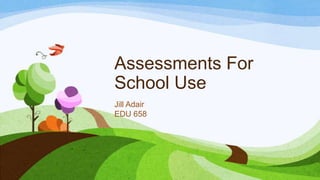
Adair Assessment Presentation
- 1. Assessments For School Use Jill Adair EDU 658
- 2. What is an assessment? • Assessments, by definition, are methods of collecting data that can analyzed to determine both strengths and weaknesses of student comprehension, track progression, and determine learning gains (Vogt & Shearer, 2011). • Assessments are categorized into two primary types with subcategories to distinguish best uses of the data collected. The two types of assessments are formative and summative. • There are four classifications of assessments which include screening, diagnostic, progress monitoring, and outcome measuring.
- 3. Formative Assessments • Formative assessments are a tool which allow the educator to see a snapshot of a student’s mastery of a concept, skill, or ability (Vogt & Shearer, 2011). • Formative assessments are designed to allow a teacher to adjust instruction to the student(s) as needed during a lesson, unit, or course to meet a student’s academic needs. • They can be both formal and informal as well as standardized. The goal is to validate instruction. Qualitative data is collected to include writing samples, finished products of a process, and so forth to ensure comparisons can be validly made about student progress. • Examples of the assessments would include personal observations, reviews, quizzes, performance tasks, student reflections on labs (Gunning, 2010).
- 4. Summative Assessments • Summative assessments are tools which are given at the end of instruction to determine level of mastery on the concepts presented over a given time period (Vogt & Shearer, 2011). For instance, an end of course exam, a unit test, or a yearly assessment based on national or state standards. • Summative assessments are administered to either an individual student or a group of students. • They mostly are quantitative since statistical data is produced at the end of the assessment. • Examples of summative assessments would include FCAT, NAPE, SAT/ACT, and end of course exams (Classroom assessment, 2012).
- 5. An interesting note: • Assessments can be both formative and summative. Simply put, “use of the assessment determines classification” (Vogt & Shearer, 2011, p.103). • An example of a test being both formative and summative is a scale test given to a flutist in the band. The director may ask the student to play a C# scale to check on fingerings and note clarity during the week the scale is assigned for learning. Then the student performs the same scale as a performance test at the end of the week for their grade.
- 6. Screening Assessments • Formative assessments administered to students that focus on specific skill or task that measures ability or mastery of a topic which will help teachers target who needs additional support (Vogt & Shearer, 2011). “They are designed to measure critical skills that are high predictors of future student performance” (p.105). • Common screening tools used by reading and language arts teachers are word lists, DIBLES, San Diego Quick, QRI (Gunning, 2010).
- 7. Diagnostic Assessments • Summative assessments given to students once screening instruments have determined a low performance or deficit for student learning or mastery of materials (Vogt & Shearer, 2011). • Diagnostic tests can be either norm-referenced or informal and require more time by the education staff to discover where the learning break has occurred. • Once the student’s problem has been diagnosed, then appropriate learning and comprehension strategies can be incorporated under a plan built directly for the student. • Examples of diagnostic assessments would include Stanford Diagnostic Tests and Woodcock Reading (Gunning, 2010).
- 8. Progress Monitoring • Formative assessments are administered throughout a given time (semester, unit, school year, etc.). The collected data on student ability gives the educator a snapshot of the student’s ability at that particular time allowing for individualized instruction or interventions to be administered to ensure mastery of the course content (Vogt & Shearer, 2011). • Assessments generally include teacher observations, running records, or FAIR results (Classroom assessment, 2012; Gunning, 2010; Vogt & Shearer, 2011).
- 9. Outcome Measurements • Summative assessments generally given at the end of a school year to determine student learning gains for a particular year and are compared to other students of the same grade level for that particular year (Vogt & Shearer, 2011). • “Group-administered, norm-referenced, standardized assessments that are often associated with high stakes” (p.105) • Examples would be NAPE, FCAT (Classroom assessment, 2012).
- 10. Conclusion • No matter the type of assessment, educators must follow an established method of evaluation for students that delivers reliable and valid insight into students’ comprehension and mastery of content materials. Being able to identify and utilize correctly the assessments offers both teacher and students a necessary component to education- what is working or not working towards student learning gains.
- 11. References • Classroom assessment. (2012). Retrieved from http://fcit.usf.edu/assessment/basic/basica.html • Gunning, T. (2010). Assessing and correcting reading and writing difficulties. (4th ed.). Boston, MA: Pearson Education, Inc. • Vogt, M., & Shearer, B. (2011). Reading specialists and literacy coaches in the real world. (3rd ed.) Boston, MA: Pearson.